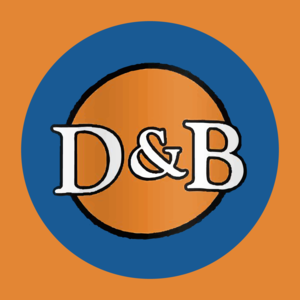
United Parks & Resorts (PRKS)
United Parks & Resorts is up against the odds. Its weak sales growth and low returns on capital show it struggled to generate demand and profits.― StockStory Analyst Team
1. News
2. Summary
Why We Think United Parks & Resorts Will Underperform
Parent company of SeaWorld and home of the world-famous Shamu, United Parks & Resorts (NYSE:PRKS) is a theme park chain featuring marine life, live entertainment, roller coasters, and waterparks.
- Annual revenue declines of 1.6% over the last two years indicate problems with its market positioning
- Lacking free cash flow limits its freedom to invest in growth initiatives, execute share buybacks, or pay dividends
- Demand will likely be soft over the next 12 months as Wall Street’s estimates imply tepid growth of 1.7%


United Parks & Resorts doesn’t live up to our standards. We see more lucrative opportunities elsewhere.
Why There Are Better Opportunities Than United Parks & Resorts
High Quality
Investable
Underperform
Why There Are Better Opportunities Than United Parks & Resorts
United Parks & Resorts is trading at $34.69 per share, or 9.1x forward P/E. United Parks & Resorts’s valuation may seem like a bargain, but we think there are valid reasons why it’s so cheap.
Cheap stocks can look like a great deal at first glance, but they can be value traps. They often have less earnings power, meaning there is more reliance on a re-rating to generate good returns - an unlikely scenario for low-quality companies.
3. United Parks & Resorts (PRKS) Research Report: Q3 CY2025 Update
Theme park operator United Parks & Resorts (NYSE:PRKS) fell short of the markets revenue expectations in Q3 CY2025, with sales falling 6.2% year on year to $511.9 million. Its GAAP profit of $1.61 per share was 28.8% below analysts’ consensus estimates.
United Parks & Resorts (PRKS) Q3 CY2025 Highlights:
- Revenue: $511.9 million vs analyst estimates of $539.8 million (6.2% year-on-year decline, 5.2% miss)
- EPS (GAAP): $1.61 vs analyst expectations of $2.26 (28.8% miss)
- Adjusted EBITDA: $216.3 million vs analyst estimates of $252.1 million (42.3% margin, 14.2% miss)
- Operating Margin: 29.6%, down from 36.8% in the same quarter last year
- Free Cash Flow Margin: 7.4%, down from 12.4% in the same quarter last year
- Visitors: 6.79 million, down 240,000 year on year
- Market Capitalization: $2.54 billion
Company Overview
Parent company of SeaWorld and home of the world-famous Shamu, United Parks & Resorts (NYSE:PRKS) is a theme park chain featuring marine life, live entertainment, roller coasters, and waterparks.
The company, originally named SeaWorld, was founded in 1964 by four UCLA graduates whose original idea was to develop an underwater restaurant. It has since rebranded into United Parks & Resorts, evolving into much more, and is known today for its aquatic shows and thrilling rides.
United Parks & Resorts's primary revenue streams are ticket sales, in-park dining, merchandise, and special events. Its parks seek to blend entertainment with marine education, enabling visitors to enjoy performances from marine animals while gaining insights into oceanic conservation.
4. Leisure Facilities
Leisure facilities companies often sell experiences rather than tangible products, and in the last decade-plus, consumers have slowly shifted their spending from "things" to "experiences". Leisure facilities seek to benefit but must innovate to do so because of the industry's high competition and capital intensity.
Competitors offering amusement park experiences nationally include Six Flags (NYSE:SIX), Cedar Fair (NYSE:FUN), and Walt Disney (NYSE:DIS).
5. Revenue Growth
A company’s long-term sales performance is one signal of its overall quality. Any business can experience short-term success, but top-performing ones enjoy sustained growth for years. Over the last five years, United Parks & Resorts grew its sales at an impressive 23.8% compounded annual growth rate. Its growth beat the average consumer discretionary company and shows its offerings resonate with customers, a helpful starting point for our analysis.
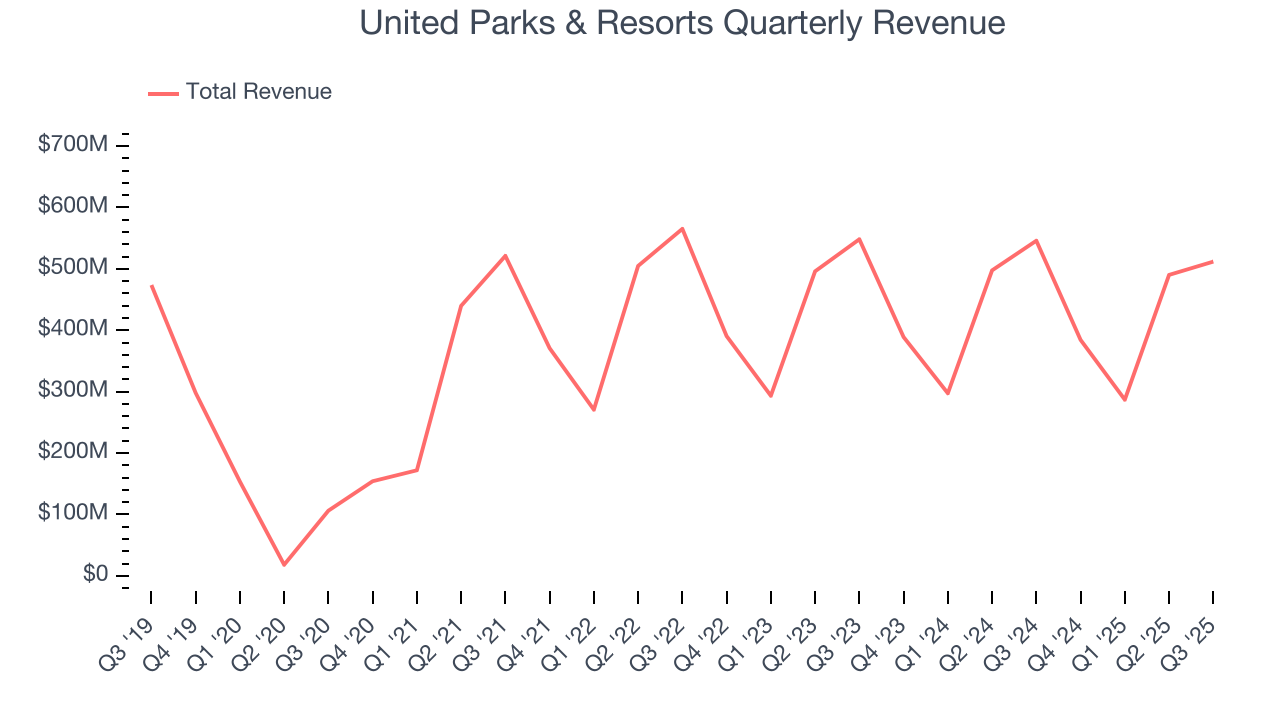
We at StockStory place the most emphasis on long-term growth, but within consumer discretionary, a stretched historical view may miss a company riding a successful new product or trend. United Parks & Resorts’s recent performance marks a sharp pivot from its five-year trend as its revenue has shown annualized declines of 1.6% over the last two years. Note that COVID hurt United Parks & Resorts’s business in 2020 and part of 2021, and it bounced back in a big way thereafter. 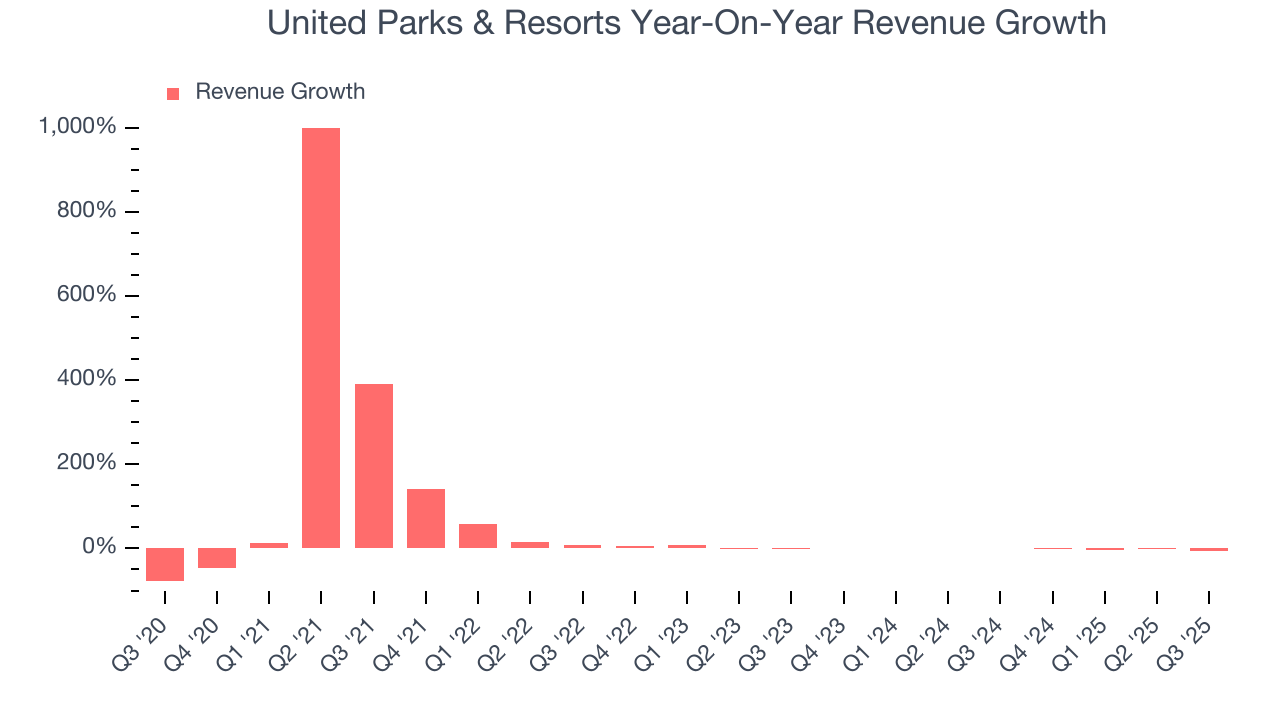
We can dig further into the company’s revenue dynamics by analyzing its number of visitors, which reached 6.79 million in the latest quarter. Over the last two years, United Parks & Resorts’s visitors were flat. Because this number aligns with its revenue growth during the same period, we can see the company’s monetization was fairly consistent. 
This quarter, United Parks & Resorts missed Wall Street’s estimates and reported a rather uninspiring 6.2% year-on-year revenue decline, generating $511.9 million of revenue.
Looking ahead, sell-side analysts expect revenue to grow 4.4% over the next 12 months. While this projection suggests its newer products and services will catalyze better top-line performance, it is still below average for the sector. At least the company is tracking well in other measures of financial health.
6. Operating Margin
Operating margin is an important measure of profitability as it shows the portion of revenue left after accounting for all core expenses – everything from the cost of goods sold to advertising and wages. It’s also useful for comparing profitability across companies with different levels of debt and tax rates because it excludes interest and taxes.
United Parks & Resorts’s operating margin has been trending down over the last 12 months, but it still averaged 25.3% over the last two years, elite for a consumer discretionary business. This shows it’s an well-run company with an efficient cost structure, and its top-notch historical revenue growth also suggests its margin dropped because it ramped up investments to capture market share, a strategy that seems to have paid off so far.
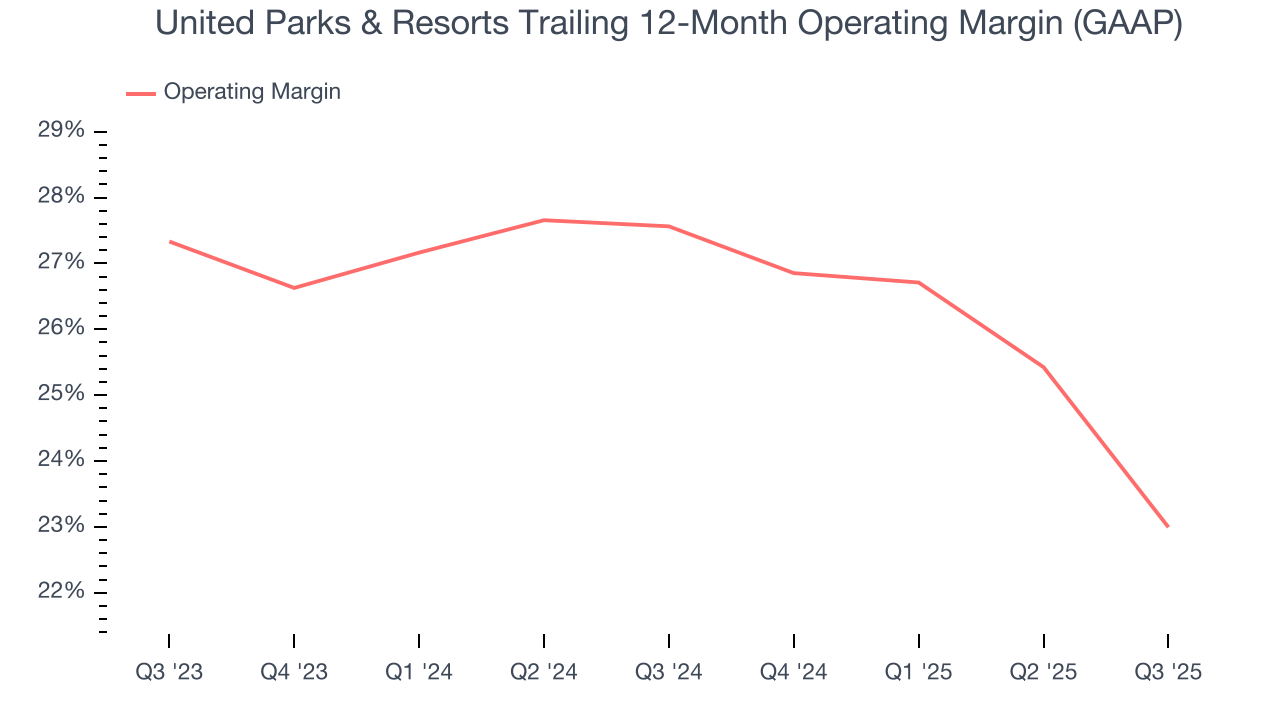
This quarter, United Parks & Resorts generated an operating margin profit margin of 29.6%, down 7.2 percentage points year on year. This contraction shows it was less efficient because its expenses increased relative to its revenue.
7. Earnings Per Share
Revenue trends explain a company’s historical growth, but the long-term change in earnings per share (EPS) points to the profitability of that growth – for example, a company could inflate its sales through excessive spending on advertising and promotions.
United Parks & Resorts’s full-year EPS flipped from negative to positive over the last five years. This is a good sign and shows it’s at an inflection point.
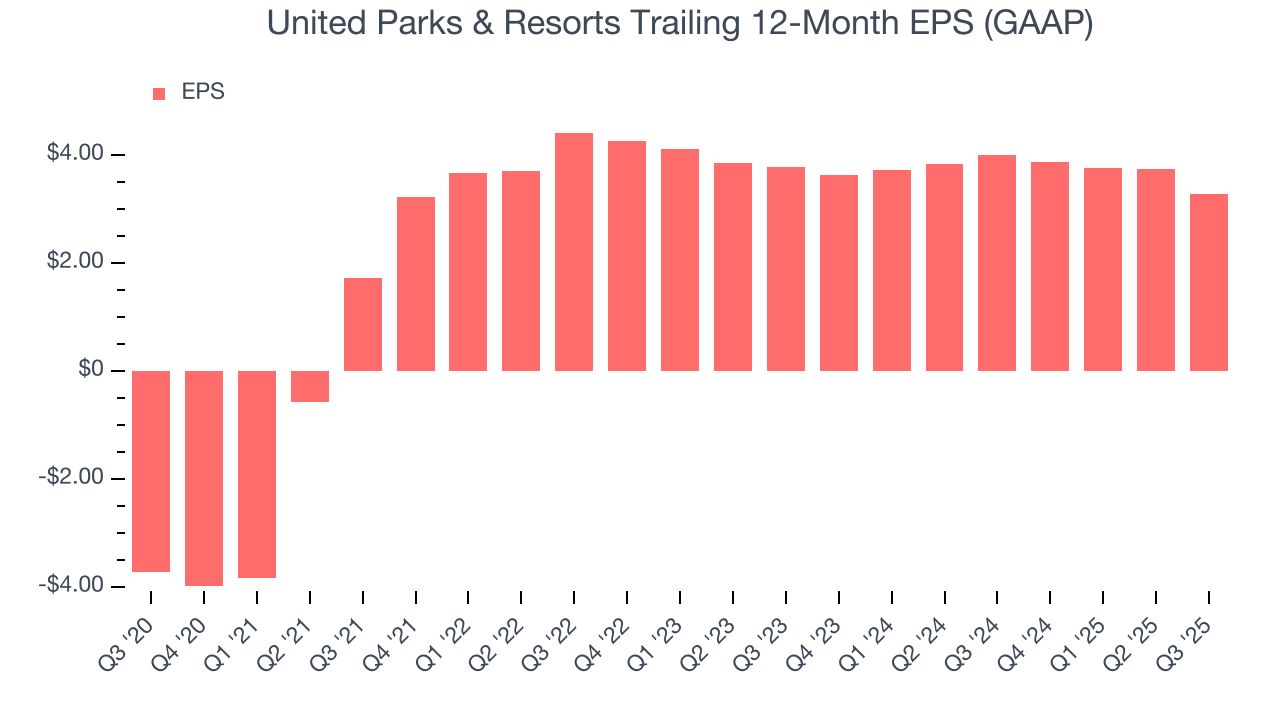
In Q3, United Parks & Resorts reported EPS of $1.61, down from $2.08 in the same quarter last year. This print missed analysts’ estimates, but we care more about long-term EPS growth than short-term movements. Over the next 12 months, Wall Street expects United Parks & Resorts’s full-year EPS of $3.27 to grow 47.5%.
8. Cash Is King
If you’ve followed StockStory for a while, you know we emphasize free cash flow. Why, you ask? We believe that in the end, cash is king, and you can’t use accounting profits to pay the bills.
United Parks & Resorts has shown decent cash profitability, giving it some flexibility to reinvest or return capital to investors. The company’s free cash flow margin averaged 11.8% over the last two years, slightly better than the broader consumer discretionary sector.
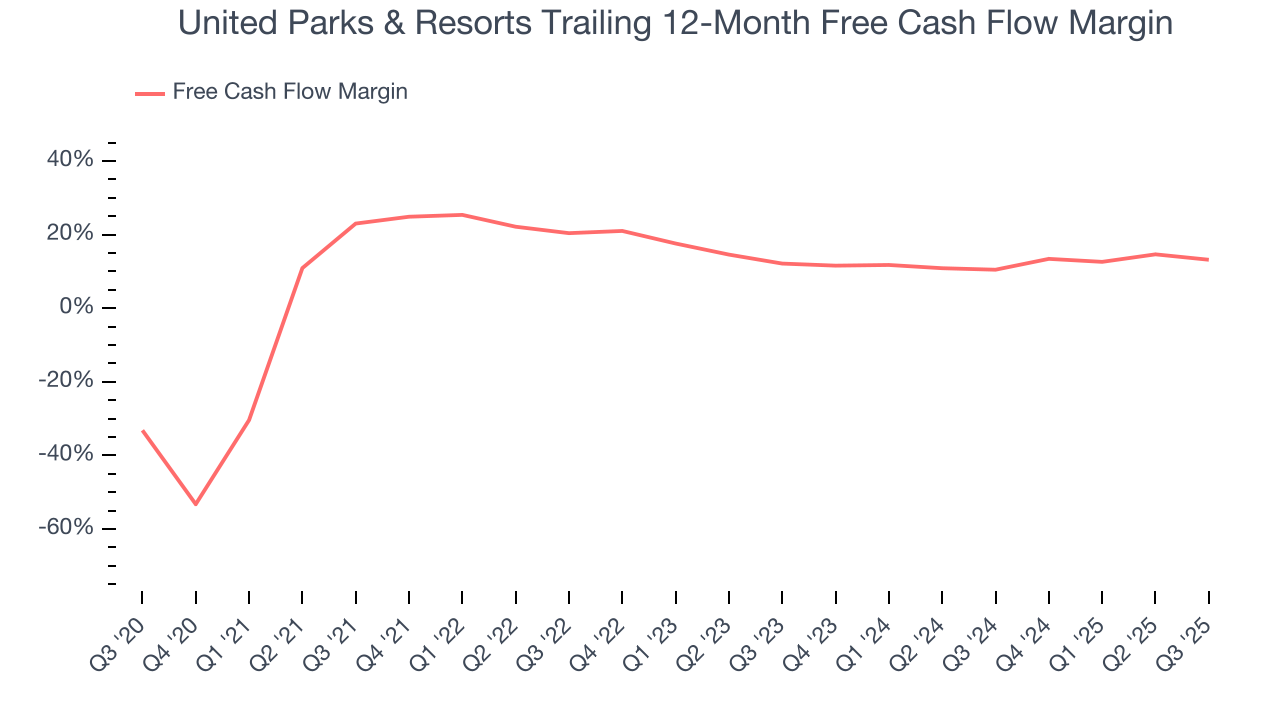
United Parks & Resorts’s free cash flow clocked in at $38.02 million in Q3, equivalent to a 7.4% margin. The company’s cash profitability regressed as it was 5 percentage points lower than in the same quarter last year, but we wouldn’t read too much into the short term because investment needs can be seasonal, leading to temporary swings. Long-term trends carry greater meaning.
9. Return on Invested Capital (ROIC)
EPS and free cash flow tell us whether a company was profitable while growing its revenue. But was it capital-efficient? Enter ROIC, a metric showing how much operating profit a company generates relative to the money it has raised (debt and equity).
United Parks & Resorts’s five-year average ROIC was 23%, placing it among the best consumer discretionary companies. This illustrates its management team’s ability to invest in highly profitable ventures and produce tangible results for shareholders.
We like to invest in businesses with high returns, but the trend in a company’s ROIC is what often surprises the market and moves the stock price. On average, United Parks & Resorts’s ROIC decreased by 1.7 percentage points annually over the last few years. Only time will tell if its new bets can bear fruit and potentially reverse the trend.
10. Balance Sheet Assessment
United Parks & Resorts reported $183.2 million of cash and $2.25 billion of debt on its balance sheet in the most recent quarter. As investors in high-quality companies, we primarily focus on two things: 1) that a company’s debt level isn’t too high and 2) that its interest payments are not excessively burdening the business.
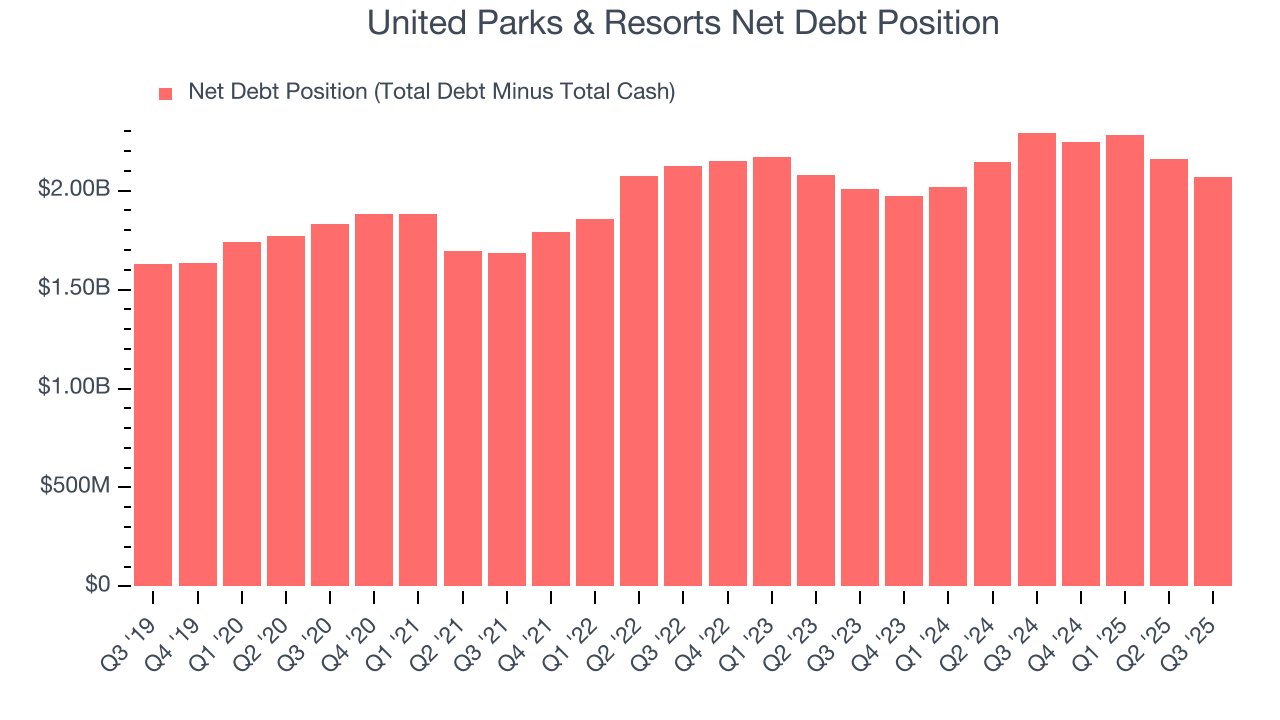
With $634.5 million of EBITDA over the last 12 months, we view United Parks & Resorts’s 3.3× net-debt-to-EBITDA ratio as safe. We also see its $118 million of annual interest expenses as appropriate. The company’s profits give it plenty of breathing room, allowing it to continue investing in growth initiatives.
11. Key Takeaways from United Parks & Resorts’s Q3 Results
We struggled to find many positives in these results. Its number of visitors missed and its revenue fell short of Wall Street’s estimates. Overall, this was a softer quarter. The stock traded down 5.9% to $43.50 immediately following the results.
12. Is Now The Time To Buy United Parks & Resorts?
Updated: December 24, 2025 at 10:12 PM EST
Before investing in or passing on United Parks & Resorts, we urge you to understand the company’s business quality (or lack thereof), valuation, and the latest quarterly results - in that order.
We cheer for all companies serving everyday consumers, but in the case of United Parks & Resorts, we’ll be cheering from the sidelines. For starters, its revenue growth was weak over the last five years, and analysts expect its demand to deteriorate over the next 12 months. On top of that, United Parks & Resorts’s number of visitors has disappointed, and its projected EPS for the next year is lacking.
United Parks & Resorts’s P/E ratio based on the next 12 months is 9.1x. While this valuation is optically cheap, the potential downside is huge given its shaky fundamentals. There are better stocks to buy right now.
Wall Street analysts have a consensus one-year price target of $44.82 on the company (compared to the current share price of $35.58).
Although the price target is bullish, readers should exercise caution because analysts tend to be overly optimistic. The firms they work for, often big banks, have relationships with companies that extend into fundraising, M&A advisory, and other rewarding business lines. As a result, they typically hesitate to say bad things for fear they will lose out. We at StockStory do not suffer from such conflicts of interest, so we’ll always tell it like it is.










